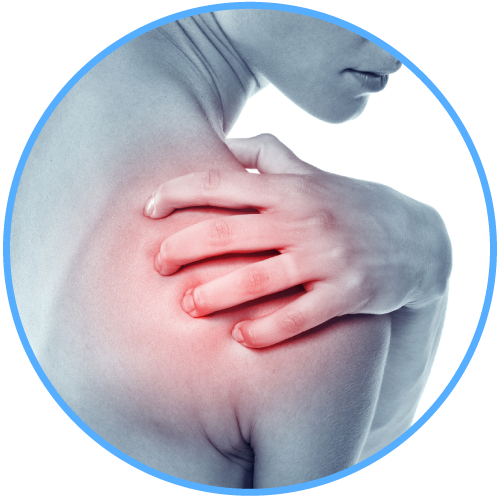
Dislocation
A dislocated shoulder is an injury in which your upper arm bone pops out of the cup-shaped socket that’s part of your shoulder blade. This can happen when an external force is applied to an outstretched arm typically in sport or a sudden trauma such as fall on an outstretched hand. Treatment includes settling the pain and stabilizing the shoulder join through a strengthening exercise programme.
Frozen Shoulder
Frozen shoulder (adhesive casulitis) is when the shoulder loses motion and becomes very painful because of inflammation within the shoulder joint. The shoulder becomes very stiff and it may be difficult for you to move it especially with overhead movements and specifically on bringing your hand behind your back. This occurs after a time when you have been less active because of another injury or recovering from a surgery or recent trauma such as a fall. Treatment for frozen shoulder includes stretching and strengthening of the shoulder joint and developing normal movement patterns while slowly restoring function gradually over time.
Rotator cuff tear
Your rotator cuff is a group of four muscles on your shoulder blade with tendons that attach to the humerus (upper arm bone). These muscles and tendons help you to lift and rotate your arms. They also help hold the ball of your humerus firmly in your shoulder socket. The tendons of your rotator cuff can tear. Sometimes, the tendon is only slightly strained or torn, however, sometimes, the tendon completely tears, which means that the tendon has torn away from the bone.
You may feel pain on top of and in front of your injured shoulder. The pain may spread down the outside of your upper arm. The pain usually gets worst at night, especially when lying on the affected side. You may have pain in the shoulder when you lift your arm to the side and often feel weakness of the arm. You may hear clicking, cracking, or popping sounds when you move your shoulder, especially when lifting something heavy.
There are several successful physiotherapy treatment options for a rotator cuff tear.
- Therapeutic soft tissue techniques and manual mobilization
- Specific exercises to restore movement and strengthen muscles
- Assessment of biomechanical abnormalities and correction to reduce stress on rotator cuff
Shoulder tendinopathy
Shoulder tendinopathy is the inflammation of the rotator cuff and/or biceps tendon. Pain in the front of the shoulder and weakness are common symptoms. It can also cause swelling of the front of the shoulder. Shoulder tendinopathy often can be relieved with rest and medication.
The goal of physiotherapy for shoulder tendinopathy is to restore full range of motion and to reduce pain in the shoulder joint. Typical physiotherapy treatment includes
- Mobilisation of joint and soft tissues around the shoulder joint
- Therapeutic exercises to strengthen the rotator cuff muscles
- Education about correct posture and importance of warm-up and stretching before activity



